The Room(s)Kid moved out? New house? However you did it, you've got a free room or maybe two?

Let's get this room ready for a project studio.
First of all, checkout the excellent circle here on room treatment and acoustics:
http://www.audiocircle.com/index.php?board=73.0There's some really smart and knowledgeable people there who have shared a lot of fantastic info. Any discussions about room acoustics should best be done there, this here is just to help you get started with some of the basic considerations.
Read this:
http://www.ethanwiner.com/acoustics.html Ethan is a regular contributor on the Acoustics Circle!
What to you want to do?Depending on your goals, you'll need at least one room and preferably two. The Control Room, where you have your DAW (Digital Audio Workstation) - or perhaps even analog gear! and your monitors, etc. If you want to record live instruments, a second 'live' room is very nice indeed as it allows you to monitor the live recording without headphones, and often the rooms want to be setup much differently acoustically too.
If you don't plan to do any live recordings of things, or not much, you can get by with just the one room just fine. Guitars can be tracked in the control room OK, since they're loud and usually mic'd up close. Vocals are hard, since you'll probably hear the computer fan and have all sorts of other nasty noises get in the mix. You can do it though - many people have - but it's trickier.
The fantastic album 'Rounds' by Fourtet was done in a single room, using the microphone which came with a cheap sound card !
So you've got a room, or maybe two. First: Consider your situation. Do you live in an apartment? Will you get evicted if you make too much noise? Outside noise bleeding in? Thin walls? All these things factor into the way you'll need to treat your room.
Sound Proofing is VERY different from
Acoustical Treatment. Unbelievably so! If you don't have to worry about making a racket and getting in trouble, great! your quest is shorter. If you're a bit more unlucky and have neighbors nearby, you'll need to do more.
Just before you get too disenchanted by that realization - if you're one with neighbors - consider that the typical monitor listening level is pretty low, and unless you're tracking live instruments like guitars and drums, your great little studio shouldn't get you evicted. There's some logic that says it's good to mix reasonably quiet anyway, due to the characteristics of human hearing.
SetupI'll share the setup of a small home studio here, as it's probably a pretty typical scenario.
Considerations:
Neighbors? Yes.. Where? Below and back wall, but back wall joins their laundry room so i get another room of isolation 'free'... kinda.
Size? OK. Not ideal, room dimensions will create some frequency nodes in key places, but i can work around that.
Budget? Everyone's is different. If you have the time you can DIY a lot of this. Investing in some portable bass traps might be a great idea if you can afford it.
Your room will probably have nasty room modes, which are peaks and valleys in the standing waves. You can use free software to determine your room modes, and deal with them or work around them (probably both)
PC:
http://www.ethanwiner.com/acoustics.html#modecalc Either:
http://www.bobgolds.com/Mode/RoomModes.htm You can find a bunch more by searching 'Room Modes calculator'. Moving your listening position, monitors, adding sound treatment stuff like bass traps, will all help you to get a somewhat neutral response in your listening position. Actual analysis can help and is great tool to see what's really going on. More on that below.
So you've got a room:
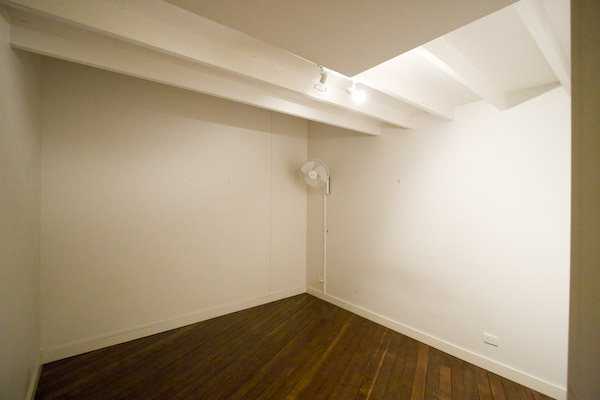
For this studios budget/time/ability, we decided to isolate the floor and back as much as possible for Sound Proofing-ish, then handle the Acoustical Treatment. Ideally for sound proofing, you'd build a room within a room and make it air tight, etc., but that was out of our budget and capability.
Make an air tight seal over the bottom using the heaviest plastic you can get.
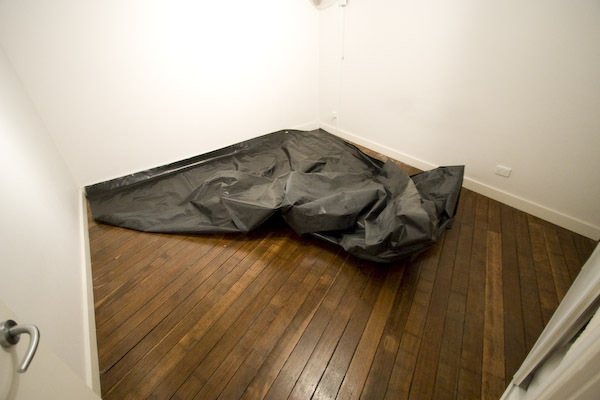
There's a number of isolation techniques. We went with the sandwich approach of (bottom up)
Plastic membrane | Rubber mat | Foam / air | Fiber cement (mass) | Glue / air / dampening | Fiber Cement (mass) | Paint
Putting two layers of fiber cement together with a thick layer of
Green Glue http://www.greengluecompany.com/greenGlueApplication.php, creates a great dampening membrane/air/mass/absorber/mass sandwich. It works very well.
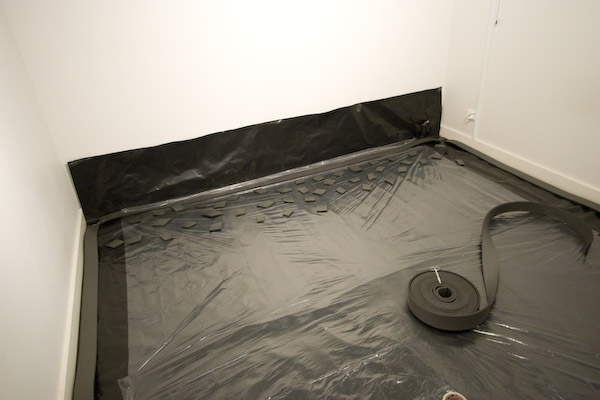
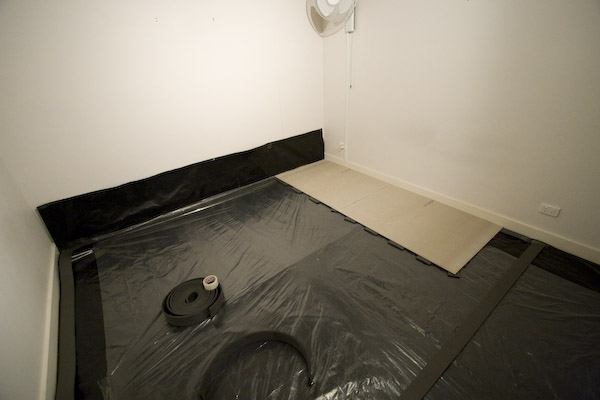
I didn't take any more shots

but basically the first floor goes down, then you squirt the glue all over it like a Jackson Pollock painting and then put the other layer down overtop. The glue acts as a vibration absorber between the two layers. The floor cost about $400, maybe cheaper where you are.
Currently: The ceiling is next to do, but overall the room is 'decent'. Far from perfect! but very workable.

The back wall has a thick curtain hanging and behind that are about 7 very heavy 'movers blankets' which have been bolted to the wall. They're supremely heavy and together are about 3-4 inches thick. It's not ideal, but it does dampen that wall down a lot!
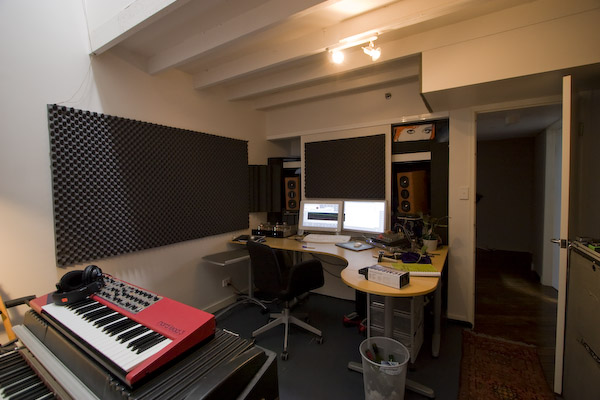

There's a really weird extrusion up to the roof which causes some nasty flutter echoes. I've had to put some absorbent material up there to tame it down, but its still a bit too wet sounding...
Ok, i'll close this out with the
Room Treatment Cheatsheet: and a bunch of links. Again, for much more detail on this topic go haunt the Acoustics Circle right here in AC
- Plan your room before you set it up. Use a room modes calculator to see if there's any surprises. You don't want to set it all up and wire everything only to find out your head is right in the middle of a big dip or lump!
- While you're sitting in the command chair, get a friend to move a mirror on each of the side walls and try to get a reflection of either monitor in view. That location is where you need to put some treatment. Proper acoustical panels, foam, blankets, a bookshelf, something... you don't want a bare wall reflecting straight onto you as it will mess up your imaging BIG TIME
- You'll probably want some bass traps if you're going to mix loud. Evan's RealTraps are probably the best performance/value. There's a number of good DIY plans and ideas out there too. For one corner i used a very large tall box filled with clothes and it worked great
- Egg cartons don't do a damn thing!
Here's a bunch of links to get you going:
Evan's link again, LOTS of good info:
http://www.ethanwiner.com/acoustics.htmlSOS article:
http://www.soundonsound.com/sos/aug98/articles/practicalacoustic.htmlSome room mode info:
http://www.ultimateavmag.com/news/10388/index.htmlSoundproofing:
http://www.uhfmag.com/Issue63/soundproofing.htmlDIY tube traps:
http://www.teresaudio.com/haven/traps/traps.htmlRecording studio acoustics:
http://arts.ucsc.edu/ems/music/tech_background/TE-14/teces_14.htmlHeres a white noise test. Not bad

time to get the show on the road!


Next up: Let's checkout some other small studios and see what they've got cookin'
Good luck!
/A